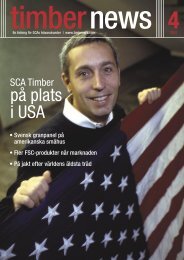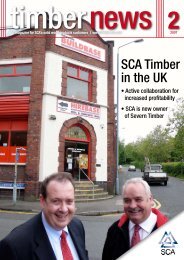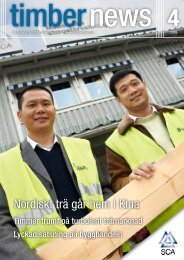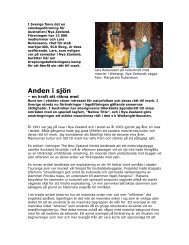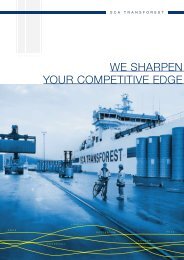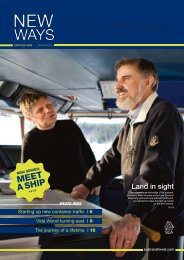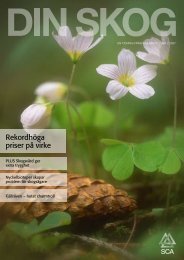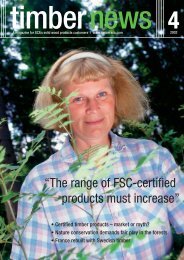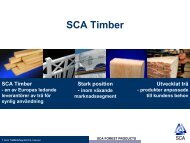Environmental Report 2001 - SCA Forest Products AB
Environmental Report 2001 - SCA Forest Products AB
Environmental Report 2001 - SCA Forest Products AB
- No tags were found...
You also want an ePaper? Increase the reach of your titles
YUMPU automatically turns print PDFs into web optimized ePapers that Google loves.
Aylesford NewsprintAn <strong>SCA</strong> <strong>Forest</strong> <strong>Products</strong>,Mondi Europe companySustaining ourenvironmentalcommitmentSafety, Health, <strong>Environmental</strong> andFire Prevention <strong>Report</strong> <strong>2001</strong>
AYLESFORD NEWSPRINT Safety, Health, <strong>Environmental</strong> and Fire Prevention <strong>Report</strong> <strong>2001</strong> 1I am pleased to be writing again in ourannual report to stakeholders and I amproud that our report has beenaccepted as reliable environmentalreference within the newsprintmanufacturing industry. I hope that youwill find our eighth report interestingand relevant to current industrial needs.The quality of our rivers and air purityare among the many issues managedby national and local Governmentagencies by regulation, but in realityare matters influenced by each andeveryone of us.Companies face equal scrutiny overtheir actions, and, because theyinteract with local communities on aday-to-day basis they should aim toexplain their production processes.In my view, this form of transparency isconstructive. It can help remove doubtsabout a company’s environmentalperformance and open up usefuldebate with our stakeholders as tohow improvements can be achieved.We all need to bear in mind thatimprovements have to be made withfull regard to the requirements ofindividual businesses and withouthampering their ability to compete intough world markets.Aylesford Newsprint has adopted thisapproach and published a series ofannual environmental reports.These reports reflect the company’svision and detail how it delivers arange of environmental and socialbenefits to the UK.They also show how adopting “greenprinciples” can be good for business, afactor that is now taken into accountby a range of stakeholder audiencesincluding:• Employees• <strong>Environmental</strong> pressure groups• Influential think-tanks• PoliticiansIn this, the <strong>2001</strong> <strong>Report</strong>, we havecontinued to record the environmentalperformance of our Kent mill andthrough a range of areas includingwaste management, energymanagement and social responsibility,demonstrated an improvedperformance.As the Chief Executive of AylesfordNewsprint, I am naturally delighted tosee the progress that we have made inso many areas and how our employeeshave performed over the past year.Over the coming months and yearswe will strive to maintain this positionand continue to further the cause ofsocial responsibility within thepapermaking industry.Alan McKendrickChief ExecutiveA letter from ourChief Executive<strong>Environmental</strong> issues are of increasing concern to people throughout the UK,regardless of whether they live in urban or rural areas and Aylesford Newsprint isdetermined to continuously improve its performance.
2 AYLESFORD NEWSPRINT Safety, Health, <strong>Environmental</strong> and Fire Prevention <strong>Report</strong> <strong>2001</strong>Aylesford Newsprint manufacturespremium quality, fully recyclednewsprint. Its product “Renaissance”is used in the production of leadingnational and local newspapers acrossthe UK and throughout Europe.It employs about 400 people whooperate its two paper machines,24 hours a day, 365 days a year.The company draws its raw materialfrom the collection of used newspapersand magazines; these arise fromkerbside schemes or from recyclingbanks. The mill can process 500,000tonnes per annum of used newspapersand magazines.The mill produces about 50 tonnes ofnewsprint per hour - 400,000 tonnesper annum - which is wrapped andstored ready for customer’s deliveryinstructions. Of the two papermachines, PM13 was constructed in1957 and has a capacity of about90,000 tonnes per annum; PM14 wascommissioned in May 1995 andcurrently has a capacity of about310,000 tonnes per annum.The global market for newsprint isabout 40 million tonnes per annumwith about 10 million tonnes producedand used in Europe. The UK uses about2.6 million tonnes per annum of whichabout 1.7 million tonnes are imported.Papermaking needs large quantities ofwater and energy, which has requiredthe mill to invest substantially infacilities for both resources. Permits areheld for the abstraction of water fromthree sources, a local millstream,groundwater and the River Medway.The water treatment plant cleans millwater prior to discharge into theRiver Medway.We produce energy using a CombinedHeat and Power plant, and alsothrough burning process residue inour combustor. The Combined Heatand Power plant is owned by Cogen,an Innogy business, although on ourland and operated by mill employees.Combined heat and power isrecognised as amongst the mostefficient means to generate energy.The combustor burns fibrous processresidue and produces up to27 tonnes/hr of steam for powergeneration and process heat demand.The combustor provides 16% of thesite energy supply. In <strong>2001</strong> steam wasnot only supplied to the newsprintplant, but also to our neighbours, <strong>SCA</strong>Packaging. Power is supplied to thenewsprint business, <strong>SCA</strong> and othersmaller businesses in the immediatearea; also a surplus of about 30 MW issupplied to the National Grid.We own a landfill site, Margetts Pit aredundant limestone quarry, which isnow used for the disposal of millproduction waste from our mill and<strong>SCA</strong> Packaging.See page 11 for the ‘AylesfordNewsprint Mill Process Diagram’.Company profileAylesford Newsprint is committed to delivering to its customers a premium qualitynewsprint, produced entirely from recycled newspapers and magazines.
4 AYLESFORD NEWSPRINT Safety, Health, <strong>Environmental</strong> and Fire Prevention <strong>Report</strong> <strong>2001</strong>Safety & HealthObjectives & targets <strong>2001</strong>Zero accidentsAll employees to completerefresher safety trainingConduct health and safetyclimate tools surveyPersonal Protective Equipment(PPE) audit of all employeesSafety, Health and Environment(SHE) ExerciseReview of appropriateness ofhealth screeningIdentify improved methodsstakeholder feedbackReview appropriateness ofthe health and safety dataincluded in the Safety, Healthand Environment <strong>Report</strong>Outcome & comments‘Zero accidents’ is a challenging target to achieve in the long term. During the year <strong>2001</strong> there were9 lost time accidents and 38 other accidents, this was an improvement on the previous two years.All employees and full time contractors have attended a minimum of one-day safetyawareness training.It was decided to postpone this survey because of the need to progress a study into behaviourat work.The audit highlighted the changes needed to allow greater participation by the employees inchoice of PPE.Two emergency exercises were held during <strong>2001</strong>. One covering two areas of the mill and theother related to a small mill area. Results from both exercises will enable us to improve the safetyand security of the mill.Current health screening was shown to be appropriate for working conditions in the mill,although improvements in the future could be beneficial.Greater participation is being encouraged among the workforce through safety representatives,safety meetings, and involvement in accident and incident investigation, continuous improvementexercises and SHEF exercises. Contractor feedback will be important during the year 2002.The review concluded that the health and safety data included in the report is appropriate.See also below.<strong>Environmental</strong>Objectives & targets <strong>2001</strong>Outcome & commentsContinued environmental Training has been delayed as the IPPC permits have to be issued by the Environment Agencyawareness training for all relevant and relevant guidance notes are still to be developed.employees (including IPPC)<strong>Environmental</strong> legislation on This has been completed and the list of current environmental legislation is available to allthe internal intranet site employees on the intranet site.Review odour management Draft plans have been submitted to the Environment Agency.plan & ground water studyat Margetts PitEstablish a new waterThe site water reduction plan has been produced and many of the recommendations will bereduction plan implemented in the year 2002.Review appropriateness of theenvironmental data in theSafety, Health and Environment<strong>Report</strong>Transport Management StudyInvestigate fugitive dustemissions from combustorThe review concluded that the fire systems should be included in the mill environmentalinformation system and that the mill policy needed to be expanded. The annual report has beendeveloped accordingly and this is the first edition of the new format.Trials of an automated, combination trailer capable of handling both recovered paper delivered tothe mill and finished goods delivered to customers were very successful. These trailers will begradually introduced during 2002, which will reduce the number of vehicles running empty.A report has been produced but all recommendations have yet to be implemented.Objectives andtargets <strong>2001</strong>Each year Aylesford Newsprint sets environmental objectives for its mill and these arecommunicated to the relevant stakeholder groups. Progress is measured and auditedduring the year.
AYLESFORD NEWSPRINT Safety, Health, <strong>Environmental</strong> and Fire Prevention <strong>Report</strong> <strong>2001</strong> 5Safety, Health & FireObjectives & targets 2002SafetySHEF ExerciseEmployee inputCommentsThe mill will hold a SHEF emergency exercise during the year, by simulating an unexpected incident,which will address either environmental or safety and health issues.The number of safety representatives will be increased to improve employee safety through greaterparticipation and communication.HealthMedical AssessmentsHealth ProgrammesFireIncidentsFire MaintenanceInitiation of medical fitness assessments for all employees. This will be in conjunction with ourprivate health providers at intervals specified by them.Ensuring the timely implementation of a regular monitoring programme for employee’s exposure tonoise, dust, heat and stress in high risk areas.Reduce fire incidents by a minimum of 50% against <strong>2001</strong> by improving housekeeping andtraining of employees.All fire system maintenance to be completed on time.<strong>Environmental</strong>Objectives & targets 2002Margetts PitLight Pollution<strong>Environmental</strong> AwarenessTraining (Brought forwardfrom <strong>2001</strong>)CommentsTo improve on the progress made with a further reduction in the number of complaints receivedconcerning the operation of the landfill site with better monitoring of the material deposited.This will be achieved by the improvement of the management skills of the landfill operatorsand supervisor.To ensure the mill maintains levels of external lighting in order to maintain safety withoutcausing difficulties to our neighbours.To provide for employee’s education that they are aware of the requirements of our IPPC Permitsand <strong>Environmental</strong> Management Systems. All employees will attend an intensive training coursetailored to their specific responsibilities. They will be required to complete feedback questionnaireson the course for developing future <strong>Environmental</strong> courses.Objectives andtargets 2002
6 AYLESFORD NEWSPRINT Safety, Health, <strong>Environmental</strong> and Fire Prevention <strong>Report</strong> <strong>2001</strong>Accidents and IncidentsAylesford Newsprint recognises theimportance of good accident andincident reporting and investigation. In1997, alongside accident reporting, anincident or near miss reporting systemwas introduced. Understanding theroot cause of near misses enablesproactive measures to be taken inpreventing accidents.Total Lost TimeAccidents Accidents Incidents1997 73 11 921998 80 9 1511999 74 14 2222000 49 16 323<strong>2001</strong> 47 9 462• Lost Time Accidents are included inTotal Accidents.• The higher figure of incidentreporting is a positive result, asinformation gained from thisreporting is instrumental in theprevention of accidents.Safety MeetingsThe involvement of employees in safetyand health is good businessmanagement. Greater emphasis hasbeen placed on the role of SafetyRepresentatives, both union andcompany appointed, who are involvedin accident and incident investigation,housekeeping and fire inspections andattending Company Safety Meetings.In 2002, a more structured approachwill be taken to the Safety Meetingstogether with participation in planningand implementing the Mill Action Plan,this to be supported by Local AreaAction Plans. Progress is reported atthe monthly Company Safety Meeting.HealthExposure to noise, working in highambient temperatures and use ofdisplay screen equipment have beenidentified as important health issues.An Occupational Health Nurse attendssite regularly to ensure that all those atrisk are monitored.Employees are being encouraged tovisit the nurse to discuss good health,life styles and to have general healthchecks.The Occupational Health Nurse acts asa key member of the company’s FirstAid Team.Contractor Health and SafetyMore emphasis was placed onContractor Health and Safety during<strong>2001</strong>. Critical maintenance contractorsare required to attend the ClientContractor National Safety Group(CCNSG) approved safety training andto gain a Contractor Passport.During <strong>2001</strong>, we implemented a processfor reporting contractor accidents,incidents and their investigation,with the contractor’s employer. Anycontractor’s accidents will be reportedwith any mill employees’ accidentsin 2002.Emergency ExercisesEmergency exercises are a requirementof the ISO 14001:1996 Standard for<strong>Environmental</strong> Management.During <strong>2001</strong>, two emergency exerciseswere carried out simulating emergencyaccidents, involving fire and personnelinjury.Both exercises will provide valuableinformation, improving emergencypreparedness and an emergencyexercise will be planned to be carriedout in 2002.FirePaper mills are areas of high fire riskand demand vigilance from employeesat all times in maintaining procedures,training and fire systems.In the first three months of <strong>2001</strong> thewrap line in the mill was subject to ahigh incidence of fires. These firesoccurred in an area where the kraftpaper, the outside wrapping forfinished product, passes over a heatedinfa-red plate.123Safety, health andsocial responsibilityAylesford Newsprint is committed to the efficient investigation of all accidents andincidents at its mill. We have a long history of sponsoring projects that raise the profile ofenvironmental issues and help to build community facilities for local people.
AYLESFORD NEWSPRINT Safety, Health, <strong>Environmental</strong> and Fire Prevention <strong>Report</strong> <strong>2001</strong> 7An average of 33 minor fires per monthwere reported during this period.Improved housekeeping, maintenanceof the equipment and continuousreporting by the crews has resulted inthe incidences of fire in this areadropping down to 1 or 2 per month.There have also been some minor firesrelated to the two paper machinesduring the year. There were no reportedfire related incidents or accidents toemployees.Social ResponsibilityAylesford Newsprint recognises theimportance of Social Responsibility toits employees, the community and theenvironment. We are committed toenabling employees to meet thedemands of a developing market placeand changing technologies throughtraining, education and development.We are proactive in training relatedactivities• The Excellence Centre is purpose builtfor the provision of a wide range oftraining courses and personaldevelopment programmes for all ouremployees. During <strong>2001</strong> employeeswere provided with 1,636 days oftraining and averaged 4.1 days perperson. The analysis below shows themain topics of training;• We are actively involved in the SouthEast Mills Training Group;• Employees achieved many qualificationsin <strong>2001</strong>;• In <strong>2001</strong> we were awarded Investorsin People for a further 3 years;• We were awarded the Mid KentCollege Business Class Award forOutstanding Commitment to StaffDevelopment.Positive employee relations aremaintained and developed throughvarious internal communicationchannels• The Operating Council, consisting ofelected employee representatives andmanagers, meets regularly to discussbusiness and employee issues;• A monthly Team Brief providescompany and business informationto all employees;• During <strong>2001</strong> the on site, mill basedIntranet became available to allemployees;• A sixteen-page company newspaper,‘The Paper’, is published regularly;• Notices boards are an effectivemeans of communications in allareas of the mill.The company is active in consultingand working in the communityRegular meetings are held withmembers of the local Burham ParishCouncil, the nearest administration toMargetts Pit, to discuss improvementsand developments of the site.Local children’s charities, primaryschools, children’s football teams anddisabled groups are among those whobenefit from Aylesford Newsprintdonations.Along with four other Kent businesses,we contributed to the funding neededfor Holmsdale Technical College, togain their technology college status.We are the leading sponsors of theEnvironment Awards for KentBusiness, now in its seventh year. Theawards are very successful with over80 entries in <strong>2001</strong>.Through the Landfill Tax CreditScheme, we support localenvironmental and communityprojects. Since 1996 the scheme hasprovided £255,000 in financialsupport to a total of 26 completedprojects, an analysis is shown below.We have donated, since 1995, inexcess of £120,000 to Great OrmondStreet Hospital, through thenewspapers and magazines recyclingbanks scheme.Employees are actively involved inmany aspects of the businesscommunity, including; theEnvironment Agency StakeholdersGroup, Paper Federation AdvisersGroup, CBI and Wastewatch.During <strong>2001</strong>, 1,636 days of employees trainingwere undertaken and the graph shows the areas oftraining provided. There was an average 4.1 daysof training per employee.4Since 1996 £290,000 has been recovered fromLandfill Tax of which £255,000 has been allocatedto 26 projects.51. IN <strong>2001</strong> EMPLOYEES PARTICIPATED IN AN AVERAGE4.1 DAYS TRAINING;2. HEALTH PROGRAMMES ARE BEING INTRODUCED TOMONITOR EMPLOYEES EXPOSED TO NOISE, DUST, HEATAND STRESS IN HIGH RISK AREAS;3. AYLESFORD NEWSPRINT RECOGNISES THE IMPORTANCEOF GOOD ACCIDENT AND INCIDENT REPORTING ANDINVESTIGATION;4. MANY LOCAL CHARITIES AND ORGANISATIONS ARESUPPORTED BY AYLESFORD NEWSPRINT. SEEN HERE,MAKING A DONATION TO KENT AIR AMBULANCE TRUST,IN PARTNERSHIP WITH SEVENOAKS DISTRICT COUNCIL;5. LIFE SAVING PROCEDURES BEING DEMONSTRATED BYTHE OCCUPATIONAL NURSE TO A COMPANY FIRST AIDER.EMPLOYEE TRAININGDAYSPROCESSSAFETY434423386PERSONAL DEV191COMPUTER / SYSTEMS121MOBILE PLANT/REFRESHER79PEOPLE SKILLS2ENVIRONMENTEXTERNAL SCHEMES FUNDED BYLANDFILL TAX SINCE OCTOBER ‘96£000’sNo OF PROJECTS92LOCAL COMMUNITIES1166.5REGENERATION550NATURE CONSERVATION846.5EDUCATION & RESEARCH2
8 AYLESFORD NEWSPRINT Safety, Health, <strong>Environmental</strong> and Fire Prevention <strong>Report</strong> <strong>2001</strong>Operation of the water treatment plantwas compliant with current regulationsand discharge limits. We were pleasedwith the reduction in the emissions ofBOD, COD and suspended solids inthe year.Papermaking requires large amounts ofwater and therefore reuse within thesystem is important to minimise theneed for freshwater and to reduce thevolume of water to be cleaned fordisposal. Last year we recycled 93% ofthe water used.In 1996, the company averaged 19.8tonnes of water abstracted for eachtonne of paper produced. In <strong>2001</strong> weachieved a comparative figure of 12.1tonnes of water abstracted. This figureplaces us well within the IPPCbenchmark levels of 8-15m 3 /tonnes ofwater for newsprint production. Lastyear, implementation of the WaterManagement Plan created a reductionof water abstraction by 11.7%.Suspended SolidsThe amount of suspended solids pertonne of paper was maintained atabout 60% of the BREF standard, andthis was the lowest annual loaddischarge to the River Medway. Thedischarge concentration was the lowestsince 1998.Biological Oxygen Demand (BOD)The amount of BOD per tonne ofpaper was maintained at about 45%of the BREF standard. The dischargeconcentration was the lowest since 1998.Chemical Oxygen Demand (COD)The amount of COD per tonne ofpaper was maintained at about 60% ofthe BREF standard and the total loadwas lower in <strong>2001</strong>, reversing a fouryeartrend. The concentration waslower than the previous two years.Pentachlorophenol (PCP)The amount of PCP per tonne of paperis on average 3% of the BREF Standard.This chemical is not used by the millbut is often found in pesticides. It isbelieved, that PCP enters the mill in theraw materials (used newspapers andmagazines), originating from forestmanagement practices through theoriginal pulp.<strong>2001</strong> COMPARATIVE DATAWATER EMISSIONSTemperatureThe temperature of water dischargedinto a river is important to the river lifeand the mill has a dischargetemperature limit of 30°C. The averagetemperature of the discharge was26.3°C for the year, rising to 27.7°C inmid summer, with peaks up to 29.2°C.Incidents <strong>Report</strong>able to theEnvironment AgencyThere were no reportable incidentsrelating to the discharge of water in<strong>2001</strong>. Two incidents regarding theabstraction of groundwater werereported. Both incidents were minor,and within the tolerances of the flowmeters. Procedures have beenimplemented to ensure avoidance ofa similar incident in the future.<strong>2001</strong> 2000million million %Kg Kg improvementSuspended Solids (Kg)- concentration mg/l68,12715.394,48317.72813.5Biological Oxygen Demand (BOD) (Kg)- concentration mg/l34,5987.842,4908.0192.5Chemical Oxygen Demand (COD) (Kg)- concentration mg/l894,9612011,080,120203171Pentachlorophenol (PCP) (Kg)- concentration ng/l0.126280.11822.1(7)(27)Temperature ( o C) 26.3 26.3 no changeAylesford Newsprint is committed to minimising the use of water in its productionprocesses and returning clean water to the River Medway.Watermanagement
AYLESFORD NEWSPRINT Safety, Health, <strong>Environmental</strong> and Fire Prevention <strong>Report</strong> <strong>2001</strong> 9Aylesford Newsprint operates theEnergy Generation (CHP) andCombustor Plant to produce steamand power. The combustion of wasteprovides approximately 16% of ourown energy requirements.During <strong>2001</strong> a new gas turbine wascommissioned increasing the capacityof the power generating plant from58MW (e) to 98 MW (e). During theyear we exported 218,000 MWh ofelectricity to the National Grid.The Aylesford CHP plant has an overallefficiency of 76% and this comparesfavourably with a conventional powerstation that has a fuel efficiencybetween 35% and 55%. The higherefficiency of our CHP plant means areduction on CO 2 per unit of energyused because less fuel is needed toproduce an equivalent amount ofenergy, therefore our plant iscontributing to reducing emissions insupport of the UK’s Climate Changestrategy. During <strong>2001</strong> we produced471,500 tonnes of CO 2 , in comparisonwith last year’s emission of 398,000tonnes. This increase was due toenlargement of the plant and theexport of 218,000 MWh of electricityto the National Grid.Oxides of NitrogenDuring the year the Board approvedreplacement of the CHP stand-byboilers (Nos. 3, 4 & 5) with moreefficient plant. They will comply withnew standards and produce less than50% of the current NO x emissions.Total Oxides of Nitrogen increased in<strong>2001</strong> by 59%, from 304,309 Kgs in2000 to 482,181 Kgs, mainly due to a54% increase in the amount of gasbeing used in the enlarged power plant.Sulphur DioxideEmissions of Sulphur Dioxide havedecreased from 8,923 Kgs to4,846 Kgs in <strong>2001</strong> because of areduction of fuel oil used in the backup boilers.ParticulateThe figures for particulates havedecreased from 858 Kgs to 531 Kgsduring the year. These results are nowmore accurately produced since theintroduction of an on line particulatemonitor.Incidents <strong>Report</strong>able to theEnvironment AgencyA reportable incident occurred duringthe year when No.1 gas turbine brieflyproduced NO x emissions greater thanthe consented level.This was due to inadequate steaminjection into the gas turbine. Thisdeficiency was promptly identified andthe fault rectified.Aylesford Newsprint is committed to the generation of energy by the mostappropriate methods and in minimising emissions arising from its on-site energyproduction plant.Energymanagement
10 AYLESFORD NEWSPRINT Safety, Health, <strong>Environmental</strong> and Fire Prevention <strong>Report</strong> <strong>2001</strong>Fibrous Process Residue is aby-product of the process which isunsuitable for recycling and in <strong>2001</strong>,86,254 tonnes were produced.This accounts for 19% of the annualvolume of used newspapers andmagazines delivered to the mill.Of this “waste” material 85% wascombusted for energy with the balancebeing processed as cover material forthe landfill site.Ash is produced from the combustionof fibrous process residue and it ismainly used for road making and othersimilar purposes at Margetts Pit. Weare currently working with others tofind processes to recycle the ash intouseful products.Other Process Residue such as staples,grit and plastics are landfilled.Other Wastes within the mill in <strong>2001</strong>amounted to 744 tonnes of generalwaste, a 34% increase on 2000 mainlydue to products from additionalmaintenance in the mill. Other wasteproducts such as metal, cardboard andused oils are managed to optimiserecycling.Margetts Pit is operated in accordancewith a Waste Management License. Aspart of an ongoing programme toimprove the quality of the site and tominimise any effect on the localenvironment, the landfill site hasbenefited from the followingimprovements:Engineering WorksAn additional service road is beingconstructed. There has beenpreparatory work for a leachatemanagement sump and investigationprobes to enable the installation of ablanket protection system for thesurrounding chalk.Monitoring & MeasurementWeekly and/or monthly monitoringof the 165 bore wells is carried outto identify any presence of landfillgas, groundwater and leachate.Groundwater Risk AssessmentA Groundwater Risk Assessment wasundertaken around the Pit(Regulation 15 assessment) in <strong>2001</strong>.FIBROUS PROCESSRESIDUE<strong>2001</strong> 2000 %tonnes tonnes improvementSolid materialContained water86,25448,72991,32151,5915.55.5Total for disposal 134,983 142,912 5.5of which:Combusted for energy 114,768 128,636 11Material landfilledAsh from Combustor 44,564 46,056 3.2Fibrous process residue 20,215 14,276 (4.2)Other process residue 2,950 3,209 8Total landfilling at Margetts Pit 67,729 63,541 (9)Odour Management PlanAn Odour Management Plan wasprepared in <strong>2001</strong>. The draft planhas been submitted to theEnvironment Agency and revisedprocedures are being implemented.ComplaintsThe company investigates allcomplaints received. There were, intotal, 25 complaints received fromlocal residents during <strong>2001</strong> relating toMargetts Pit. Of these 25, 14 weresubstantiated complaints generallyrelating to odour. The reduction incomplaints, from the 51 received in2000, was achieved by identifying anddiverting unsuitable material. Thismaterial was odorous and resulted incomplaints by the local community.Other mill waste 744 557 (34)Aylesford Newsprint is committed to the re-use of its waste products andminimising the amount of waste materials that are sent to landfill.Mill wastemanagement
AYLESFORD NEWSPRINT Safety, Health, <strong>Environmental</strong> and Fire Prevention <strong>Report</strong> <strong>2001</strong> 11Mill process diagramAylesford Newsprint Mill employsstate of the art paper makingtechnologies and includes aninnovative range of environmentalfeatures, all of which create a longterm production facility.Page 2 of this report providesinformation concerning thecompany’s production processes andhelpful information on the globalnewsprint market.Margetts PitLandfillTo LandfillAshCombustorAir EmissionsMaterialsfor RecyclingPulp & PaperProductionRecovered PaperTo LandfillFibrePreparationPlantPM 13Production WasteFibrous Process ResiduesPulpSteam &EnergySteam & ElectricityCombinedHeat & PowerWaterWasteGasElectricityTo External CustomersGround WaterMill StreamRiver WaterRenaissanceNewsprintPM 14Process WaterWaterDischargedWaterTreatmentPlantRiver MedwayRoadShip
AYLESFORD NEWSPRINT Safety, Health, <strong>Environmental</strong> and Fire Prevention <strong>Report</strong> <strong>2001</strong> 16Glossary of termsAsh An inert material resulting from thecombustion of process residueBAT Best Available Techniques – arequirement of IPPCBOD Biochemical-determined oxygendemand. Biodegradable organic material inwater can be described by the requirementfor dissolved oxygen in the aerobicmicrobiological breakdown of the material.The BOD measurement indicates itspotential to pollute a waterway by deoxygenationBREF BAT Reference DocumentsCCNSG Client Contractor National SafetyGroup, responsible for content ofcontractor training courses and monitoringof the providers of the trainingCHP The combined generation of heat andpowerCOD Chemical Oxygen Demand. A measureof the amount of oxygen needed to breakdown any organic content of water. Thisindicates the content of degradable organicmatter presentContinuous Improvement Process ofenhancing the management system toachieve improvements in overallperformanceContractor’s Passport A card carried bycontractors who have successfullycompleted a two day safety training courseCO 2 Carbon Dioxide, a greenhouse gasproduced from the combustion of carbonEA Environment Agency - Regulatory bodyin England and Wales responsible forprotecting and improving the environmentFibrous Process Residue A water basedmaterial removed from the papermakingprocess, consisting of non-toxic, very smallcellulose fibres and fillers such as chalk andclay, together with printing inkFPP Fibre Preparation Plant. The part of themill in which the pulp is prepared forpapermakingGlobal Warming Also known as thegreenhouse effect, is an increase in averagetemperature of the atmosphere caused bythe absorption by certain gases e.g. carbondioxide and methaneIPC Integrated Pollution Control, beingreplaced by IPPCIPPC Integrated Pollution Prevention andControl, an EC Directive implemented inOctober 1999 and applicable to the pulpand paper industry from December 2000ISO 9002 An international qualitymanagement systems standardISO 14001 An international environmentalmanagement systems standardLandfill Tax A tax on waste materialsdelivered to landfill for disposal. The toprate is £11/tonne (£12/tonne from April<strong>2001</strong>). Developed to encourage wasteminimisation and recyclingLignin Natural adhesive found within treesto impart rigidityMill Action Group A plan of objectives forimprovement to health and safety ofemployees in the mill required by theHealth and Safety ExecutiveMW Mega Watt, a unit of energyMW(e) Mega Watt electrical, a unit ofenergy consumed or produced as electricalenergyMWh Mega Watt hour, a unit of energyused over one hourNOx Oxides of nitrogen, produced whenfuel is combusted and reacts with nitrogenParticulate Particles of ash formed duringcombustionPCP Pentachlorophenol is used as a woodpreservative or pesticide and enters the millthrough the used newspapers andmagazinesPM Paper machine – a machine used tomake paperPost Consumer Supply Used newspapersand magazines recovered from the publicthrough recycling schemesPPE Personal protective equipmentPre-Consumer Supply Over issuenewspapers and magazines obtained frompublishers/wholesalersRenaissance The brand name for AylesfordNewsprint’s product, a premium gradenewsprint, for the printing of leadingEuropean newspapersSHE Policy Safety, Health and<strong>Environmental</strong> PolicySHEF Policy Safety, Health, <strong>Environmental</strong>and Fire PolicySO 2 Sulphur dioxide, which is producedfrom sulphur in the fuel during thecombustion processSouth East Mills Training GroupA consortium of operations and trainingstaff from paper mills in the South East ofEngland. Recognised as a regional traininggroup by the Paper Education and TrainingCouncilSuspended Solids Suspended solids areinsoluble matter, which can be found inwater. The material tends to form silt,causing a reduction in the availability offood in watercoursesThird Party Landfill A landfill site notowned by the company
17 AYLESFORD NEWSPRINT Safety, Health, <strong>Environmental</strong> and Fire Prevention <strong>Report</strong> <strong>2001</strong>Independent reviewThe Aylesford Newsprint Safety, Health, <strong>Environmental</strong> and Fire Prevention <strong>Report</strong> <strong>2001</strong>(“the <strong>Report</strong>”), covers Aylesford Newsprint’s operations. The <strong>Report</strong> is the responsibilityof, and has been approved by, the Directors.The information contained in the <strong>Report</strong> hasbeen subject to an independent review carriedout by PricewaterhouseCoopers. The objectivesof the review were to:(a) assess the scope, content and format ofthe <strong>Report</strong>, to determine whether thematerial safety, health and environmentalaspects of Aylesford Newsprint’s operationsare fairly addressed and presented inthe <strong>Report</strong>;(b) assess the reliability of reporting systemsand data relating to emissions to water,air and land, natural resource use,transport of material, lost time accidentsand incidents, included in pages 6 to 15of the <strong>Report</strong>.There are no generally accepted internationalstandards for the preparation or assuranceof corporate safety, health, environmentaland fire prevention reports. In the absenceof such standards, our approach is basedon emerging best practice and theunderlying principles within internationalstandards for assurance engagements. Wetherefore planned and performed our workin order to obtain reasonable assurance onthe information tested. We believe our workprovides a reasonable basis for our findings.In preparing our findings below, we havenot conducted an audit as defined inauditing standards, and we do not expressan audit opinion on the performance datain the <strong>Report</strong>.In respect of (a), our work consisted ofinterviews with management responsiblefor safety, health and environmentalmatters, transport and logistics; a site visit;examination of documentation on currentenvironmental policies, practices andperformance; and limited desktop review ofexternal safety, health and environmentalissues affecting Aylesford Newsprint.In respect of (b), our review comprised anassessment of the systems for datacollection, analysis, consolidation andreporting, and checking samples of the datafor each of the relevant areas of safety,health and environmental performance. Thefinal <strong>Report</strong> was then examined to ensurethat the content was consistent with theinformation gathered during our work.Review findingsOn the basis of the information provided tous by Aylesford Newsprint during ourreview, we found that:• material safety, health and environmentalaspects of Aylesford Newsprint’soperations are fairly addressed andpresented in the <strong>Report</strong>.• our testing indicated that the systemsused to produce the data in the <strong>Report</strong>relating to emissions to water, land andair, natural resource use, transport ofmaterials, lost time accidents andincidents, are reliable. The informationand performance data included in the<strong>Report</strong> (on pages 6 to 15) are consistentwith the findings from our work.During the independent review we made anumber of observations, which have beenreported to management, on the content ofthe <strong>Report</strong>, the processes used to compilethe <strong>Report</strong> and on the future direction ofsafety, health, environmental and socialresponsibility management and reportingwithin Aylesford Newsprint. Our maincomments are that:• Aylesford Newsprint’s Management hasdemonstrated commitment to theprinciples within its Safety, Health,<strong>Environmental</strong> and Fire Prevention Policy.It has, in particular, sought to focusattention on health and safety across thefacility, and the number of lost timeaccidents has fallen since last year.• We recommend that a number ofadditional parameters be considered forreporting, in line with best practicedetailed in the Global <strong>Report</strong>ing Initiative,Greenhouse Gas Protocol, and DEFRA<strong>Environmental</strong> <strong>Report</strong>ing Guidelines. Inparticular, reporting on greenhouse gasemissions could be expanded to includeassessment of direct emissions fromMargetts Pit, and both direct andindirect emissions from transportactivities. The quantities of selectedchemicals used within the papermakingprocess should also be reported, inparticular hydrogen peroxide, causticsoda, sulphuric acid and sodium silicate.• Emerging best practice is to report on awider range of issues relating tocorporate social responsibility. Inparticular, Aylesford Newsprint couldconsider reporting further informationon employee issues, customer satisfaction,and relationships with third parties suchas outsourcing partners.PricewaterhouseCoopers, London,28th June 2002Designed by In Unison Design Consultants, London 020 7396 7405. Printed by The Colourhouse Ltd.
Aylesford Newsprint <strong>Environmental</strong> <strong>Report</strong> <strong>2001</strong>Please tell us what you thought of our latest report by completing this questionnaire.1 I found the report to be: very informative informative not very informative. Why not?2 The report answered: all of my questions some of my questions none of my questions. For example3 The length of report is: too long about right too short. What is missing?4 Would you like to receive future reports? yes noNameOrganisationAddressThank you for your comments.If you prefer not to send this questionnaire but would like to offer comments or receive further information,please contact Donald Charlesworth on telephone: 01622 796336, fax: 01622 796234 orEmail: donald.charlesworth@aylnews.com
Aylesford Newsprint LtdNewsprint HouseBellingham WayAylesfordKent ME20 7DLTel: 01622 796000Fax: 01622 796001Web site: www.aylesford-newsprint.co.uk



